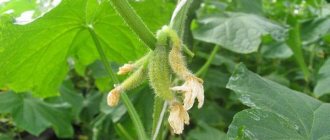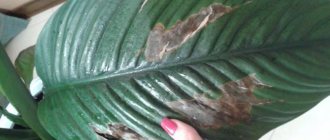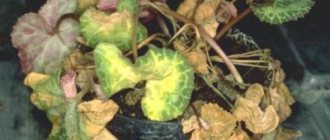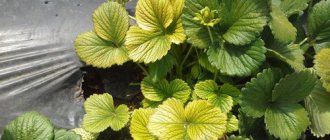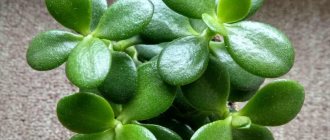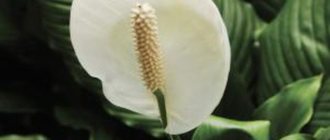Why do cucumber leaves dry in open ground and greenhouses: reasons and what to do in each case
Experts identify 4 main reasons for this phenomenon:
- violation of disembarkation rules;
- improper care;
- illness;
- pests
We will dwell on each of them in more detail.
Important! During the daytime, in hot weather, the leaves may lose their usual elasticity, which returns with the onset of coolness. This process is normal and does not require additional intervention.
Incorrect landing
| Cause | So how should it be |
| Incorrect landing | Cucumbers can be transferred to open ground only when the soil warms up to 12 degrees Celsius and the air temperature does not drop below 15 degrees. In addition, it is necessary to follow clear picking rules, as well as use the optimal placement scheme. |
| Wrong place | Cucumbers love sunlight, so when choosing a location, you should choose a well-lit space in your area. If there is not enough sun or trees growing nearby create abundant shade, the seedlings will be weak and begin to wither. Another condition for good growth is wide beds. If they are too narrow, the soil will dry out quickly, there will be a lack of moisture and the cucumbers will die. In order to ensure better air circulation and retain moisture, sometimes it is enough to simply thin out the plantings. |
| Violation of crop rotation rules | Cucumbers get along quite successfully with different types of plants and grow where other plantings sat before. For example, seedlings will be quite comfortable where cabbage, garlic, peppers and onions recently grew. Legumes, radishes, corn and turnips will be good neighbors for them. But the bed after melons and pumpkin crops is not suitable for cucumbers. There is a risk of no ovaries or extremely low yields. It is strictly not recommended to plant cucumbers next to tomatoes, although many summer residents make this mistake. Their preferences for humidity, air temperature and ventilation are diametrically opposed. In addition, the powerful root system of tomatoes can suppress the modest roots of cucumbers, which will make the bush stunted and unviable. |
| Excessive planting density | Experts recommend planting no more than 4 cucumbers per 1 square meter. If you plant the plants too tightly, then when they grow into a vine, they will firmly adhere to each other. This will hinder the development of ovaries due to lack of light and cramped space. If, after all, when cucumbers grow, it becomes clear that they are located quite close to each other, then you should not replant them. Most likely, they will not take root in the new place. The optimal solution is to either thin out the garden bed or regularly trim the shoots and do everything possible to prevent them from intertwining. |
Improper care
We will look at the main mistakes when caring for cucumbers in the table below.
| Error | Main features | What to do |
| Lack of lighting | Due to a lack of sunlight, the production of chlorophyll in the leaves decreases. It is for this reason that the lower leaves most often dry out. | Check the planting density; it is quite possible that even with good lighting, densely planted cucumbers still do not have enough light to form ovaries. Sometimes it is enough to simply thin out the bed so that the distance between the trellises is at least one meter. To ensure that the light is distributed evenly, experts recommend placing plantings from east to west, avoiding places where additional shadow is created by other plants. |
| Insufficient or too much watering | Often leaves dry out due to lack of moisture. This crop loves moist soil, but you should not be overzealous with watering - the roots do not need excess moisture. | You need to follow the advice: water the cucumbers more often, but in less volume. When it's too hot outside, evaporation from the surface of the earth increases, and water often goes into the atmosphere before it gets to the roots. This is why it is important to water cucumbers in the morning and evening. Water that is too cold should not be used for irrigation; it must first be kept warm so that the lower temperature threshold is +22 degrees. It is considered optimal to moisten the soil to a depth of 10 cm. If your cucumbers grow in a greenhouse, then once every 2-3 days you need to pour a bucket of water per square meter. If you find that the leaves of the cucumbers are withering and drying out, and the soil is squishing, then you need to loosen the soil and sprinkle it with ash and sand. They will absorb excess liquid. If you have established watering, but the leaves continue to turn yellow, then the reason should be sought elsewhere. |
| Sunburn | If drops of water remain on the leaves after watering, then exposure to sunlight may cause burns. They look like small dry spots on the surface of the leaf plate. | The optimal time for watering cucumbers is early morning or evening, when the sun is not yet so aggressive. If there is no other time than daytime, then you need to pour water exclusively at the root. The greenhouse must be regularly ventilated so that condensation does not accumulate on the surface of the walls and roof and does not rain on the plantings. |
| Hypothermia | When the temperature drops sharply, the leaves may dry out. | If the daytime temperature is very different from the nighttime temperature, then cucumbers in open ground must be covered with film. This will help keep you warm and prevent hypothermia. |
| Lack of nutrients | If watering is normalized and there is enough sunlight, but the leaves still dry out, then you should think about proper feeding. Dry leaf edges may indicate a lack of potassium and magnesium. The upper leaves may turn yellow and dry out as a result of copper deficiency. Pale veins on the plates appear due to a lack of manganese. If the edges of the leaves on the top of your cucumbers are drying out, it may be due to a lack of iron. | Experts recommend using the hydroponics method when growing, when the seedlings do not come into contact with the ground, but live and develop in their own nutrient mixture in a separate pot. If your plantings grow directly in the ground, then do not forget to regularly fertilize the soil with special mixtures, which are available in a wide range in specialized stores. |
| Nitrogen deficiency | With nitrogen deficiency, the entire green mass begins to turn yellow, the leaves curl and fall off. | The problem will be eliminated by a solution of ammonium nitrate, diluted in proportions of 10 grams per 10 liters. |
| Excess fertilizer | If the soil is too nutrient dense, problems with foliage may also occur. It is quite difficult to identify them at home. They are taken into account when all other causes of leaf damage have been excluded. | Sprinkling the soil generously with warm water will help solve the problem. |
Cucumber diseases
Very often, cucumber leaves turn yellow and dry out due to numerous plant diseases.
| Disease | Signs | What to do |
| Fusarium | Initially, the disease affects the roots of the plantings, resulting in the formation of root rot. At the next stage, dry white spots appear on the leaves, then the stems dry out and become thinner. In its advanced form, fusarium affects the entire bush, resulting in its death. | The cause of the disease may be poor-quality seeds, poorly prepared soil, or proximity to infected plantings. You can fight fusarium with the help of such means as: Trichophyte, Vitaros, Benomil and others. The concentrations of the solution and the method of application are described in detail in the attached instructions. Plantings are processed at intervals of 10 days. |
| Powdery mildew | This disease is characterized by a white coating on the leaves, similar to flour, after which they curl and dry out. | To prevent and treat powdery mildew, you can purchase a specialized product that certainly includes copper. Some gardeners use folk remedies, diluting a tablespoon of soda in 10 liters of water and treating the resulting planting concentrate. You can also use a solution of Bordeaux mixture. |
| Downy mildew | This disease manifests itself during the formation of the ovaries. The upper part of the leaf is covered with brown spots, and the lower part is covered with a powdery coating. The disease develops rapidly, the bush dies in just a week, so it is very important to start treatment in a timely manner. | Peronosporosis is a fungal infection. It appears at high humidity and low air temperature no higher than 9 degrees. To treat it, it is necessary to treat the plantings with a special agent (Rizoplan, Oksikhom). After this, it is recommended to stop watering for a week. It should be noted that the treatment is carried out in the evening and before the first fruits appear. |
| Anthracnose | As a result of the disease, the fruits become covered with yellow bumps, and yellowish spots appear on the leaves, which then turn into holes. | A favorable environment for the development of fungus is high humidity. The cause of the disease can be weeds, infected neighbors and insect pests. To combat anthracnose, a solution of 1% colloidal sulfur is used, which is used to treat the green mass of plants. After 1-2 weeks, cucumbers should be sprayed with a 1% solution of Bordeaux mixture. The affected areas can be sprayed with copper sulfate (0.5%), and local areas where holes have formed can be sprinkled with ash. |
| Cucumber mosaic | With this disease, light star-shaped spots appear on the leaves. They spread over the entire surface of the plate and merge into one. The leaf dries and turns yellow, the fruits become deformed and lose their usual color, acquiring mosaic spots. If you miss the disease, you can lose half the harvest. Most often it develops in greenhouses and comes in two types: white and green speckled. The first is considered the most harmful for plantings. | The main carriers of diseases are insects; sometimes infection occurs through contaminated garden tools. The difficulty of treatment lies in the fact that microorganisms that survive chemical treatment acquire immunity to the substances used, which is inherited. It is useless to use the same remedy a second time. Experienced gardeners use the preparations Aeteliik and Aktaru, as well as a mixture of Bordeaux mixture and liquid green soap, to combat mosaic. Among folk remedies, experts prefer a whey solution, which is used to spray the plantings. For greater effectiveness, you can add a few drops of iodine to it. |
Pests
| Pest | Signs | What to do |
| melon aphid | When aphids appear, the leaf edges turn yellow. In addition, the leaves can turn black due to a sooty fungus, which readily lives in the remains of aphids. Then the leaves are rolled into a tube and dried. This happens because the pest sucks the juices out of the plant. You can detect the parasite by turning the leaf over. It is there that a colony of aphids, small insects with a body length of 1 to 2 mm, prefers to settle. They move onto cucumbers from nearby weeds. | You need to save cucumbers from the pest immediately. To kill aphids, use a potassium-phosphorus solution (5 g of potassium salt and 10 g of superphosphate per bucket of water). The resulting substrate must be left for two days, and then the plantings must be treated with it. In the fight against the pest, laundry soap (200 g) diluted in a bucket of water, as well as local sprinkling of crushed sulfur, helps. Experienced gardeners also use onion peel tincture, treating infected areas every 5 days in the morning and evening. To prepare it, 400-500 g of husk is poured with hot water and left for 48 hours, after which 40 g of laundry soap are diluted in the resulting solution. If there are too many aphids, then you can buy a specialized chemical product (Decis, Intavir and others). |
| Spider mite | The main sign of the pest is the appearance of cobwebs and white spots on the leaves. The tick itself has a soft small body measuring no more than 0.6 mm. It feeds on plant juices and multiplies quite quickly, which leads to the death of plantings in an advanced form of infection. | One of the effective folk remedies is spraying with a tincture of half a bucket of marigolds, filled with a bucket of warm water. This solution should sit for 48 hours, after which a small piece of laundry soap (40-50g) is dissolved in it. Among the means of mass production, Acaricide (chemical) and Fitoverm (biological) are distinguished. The results from their use last for a week. |
| Nematode | This disease has symptoms similar to root rot. Nematode larvae feed on the juices of the roots of plantings, as a result of which the conductivity of nutrients and moisture to the leaves and stem is disrupted. The parasite can only be recognized after digging up the roots. | If cucumbers are infected with a roundworm, then it is no longer possible to cure the plant. All that remains is to dig up the cucumber with its roots and carefully inspect the hole so that there are no parasites left in it. To prevent the appearance of nematodes, nematicides are used (Aktofit, Fitoverm, etc.). They are applied a few days before planting cucumbers. During the growing season, you can use systemic chemicals - Marshall, Carbofuran, Alanicarb and others. You need to work with them in an open, well-ventilated area; if the processing takes place in a greenhouse, you need to use a respirator. |
| Mealybug | The leaves become limp and drooping, and a sticky mass appears on their surface. | Among the folk remedies in the fight against the parasite, a soap solution in the amount of 15 g per liter of water is effective. They wash the affected areas of the plantings. You can use an oily substance by mixing any vegetable oil (1 tsp) in half a liter of water. You can also prepare a tincture of horsetail by pouring a teaspoon of the dried plant into a glass of warm water and leaving it in a water bath for half an hour. Treatment is carried out every 5 days three times. If there are a lot of parasites, then it is better to use chemicals (Fitoverm, Aktara). Spraying is carried out every two weeks. |
How to understand why cucumbers wither
To accurately determine the causes of wilting, plants are examined first of all for the presence of diseases. With fungal infections, the color of the vegetative part at the bottom of the bush changes: fungal spores live in the soil, infect the vines from the root collar and gradually make their way up.
Colonies of pests cover mainly the back side of leaves and stems.
If leaves in open ground lose their elasticity during the day, but restore it in the evening, the reason is a lack of moisture. Similar symptoms are observed with sunburn, but then the outer surface of the leaves is covered in places with yellow spots.
Attention! A lack of nutrients in the soil causes the bushes to wilt, as does their excess.
If after watering the water does not go into the ground within an hour, this means that the soil under the cucumbers is waterlogged and needs to be mulched.
Cucumbers dry out: analysis of the reasons depending on the symptoms
Let's talk about the reasons why cucumber leaves may dry unevenly, at the edges, curl, etc.
Cucumber leaves turn yellow and dry unevenly, in spots
Quite often, various spots can be seen on the surface of cucumber leaves - from white to brown-brown. There may be several reasons for their appearance:
- Sunburn. If in hot weather drops of water fall on a sheet, then after they dry, a stain will remain on its surface - a burn. This will not lead to the death of the plant, but it is still not recommended to repeat the mistake.
- Powdery mildew. This disease manifests itself as yellow spots of a regular round shape with a white coating on the back of the leaf. Affected leaves begin to turn yellow and die. It is completely impossible to get rid of the parasite, but it is quite possible to contain its spread throughout the plantings in order to have time to harvest. To do this, cucumbers are treated with specialized preparations in accordance with the instructions supplied with them. But at the end of the season, the bushes will need to be destroyed and the ground will need to be disinfected.
- Anthracnose. Most often, this fungus affects the leaves of cucumbers. But then it moves to the stem and fruits. With anthracnose, yellow or brown spots appear that appear to be pressed into the surface. Later, when pressed, they become soft and loose, like ulcers. The disease is treated with the use of universal fungicides. For prevention, plants should be sprayed with a solution of 1% Bordeaux mixture.
Cucumber leaves turn yellow and dry around the edges
Changing leaf color often indicates a problem with the plant. Typically, deformation begins at the edges of the sheet. Let's look at the main reasons:
- Lack of moisture in the soil and dry air lead to the leaf turning yellow and drying out. It usually starts at the edges. To improve the situation, it is enough to arrange watering.
- Damage to leaf edges is often due to a fungal attack. To prevent and treat diseases, you can use a solution of Bordeaux mixture or other specialized products. The main thing is to follow the instructions so as not to cause even more harm to the plant.
- Paleness and burning of the ends of the leaf may indicate a lack of potassium in its cells. The situation can be corrected by feeding the plantings with potassium permanganate.
Cucumber leaves curl and become deformed
Leaf deformation is a rather alarming sign that may indicate a number of serious problems and diseases:
- Powdery mildew. Cucumbers usually get sick from it in mid-July and can die if not treated in a timely manner.
- Aphids or spider mites. These parasites can be easily detected by looking at the back of the leaf - this is where aphid colonies and white cobwebby coating from mites are located.
- Lack of nitrogen. Nitrogen is necessary for normal growth and development of plantings. If it is deficient, castings may become twisted and deformed. Fertilizing the soil with fertilizers that contain nitrogen will help.
- Burn. If the leaves of cucumbers come into contact with the walls or roof of the greenhouse, then in extreme heat or frost the leaves may be subject to traumatic effects, which will lead to a change in their shape and withering of the plantings.
- Moisture deficiency. With insufficient watering or excessively dry air, cucumber leaves begin to curl to reduce the area of evaporation. This protective mechanism will remain in effect until the problem is resolved.
- If none of the above points suits you, then most likely the plantings have been attacked by viruses. It is no longer possible to cure them; the affected bushes should be destroyed to avoid infecting other plants.
The lower leaves of the cucumbers have turned yellow and dried out.
If changes occur to the lower leaves of the plantings, then there is most likely no reason to panic. In nature, it is so customary that as plants grow, they get rid of the lower leaves in order to give life to new shoots.
For cucumbers, the main indicator of health is the juicy and evenly colored upper leaves, which are located in the illuminated part of the greenhouse. If there are no problems with them, then there is no need to worry about the bottom sheets falling off.
Cucumber leaves turn yellow and dry on the balcony and windowsill (window)
If your seedlings at home show alarming signs, the leaves turn yellow and dry, then there may be several reasons for this:
- Tight pots. The root system of cucumbers develops rapidly, so the chosen containers for planting may become cramped. Because of this, the plant begins to wither. In this case, an unscheduled transplant will be required. Cucumbers don’t like this too much, but there is no other way to preserve the plants.
- Lack of nutrients. When sprouting at home, seedlings quickly absorb all the nutrients from the soil. For full growth and development of cucumbers, they need to be fed before and after picking. Nitrogen fertilizers are recommended to be used after the first leaves appear, and potassium fertilizers - immediately before planting.
- If cucumbers grow on a glassed-in loggia, they may be exposed to the greenhouse effect. Observe ventilation modes and do not allow air humidity to increase.
Signs of drying out of seedlings and adult cucumber bushes
Experienced summer residents can understand possible problems by the appearance of cucumber bushes and leaves. First of all, let's look at how leaves can change.
The edges of the leaves dry out
One of the most common problems is drying out and curling of the very edge of the leaf blade. The middle of the leaf often remains green and fresh, the edge first turns yellow, then dries out, curls and begins to crumble. In the future, if no measures are taken, the cucumber leaf will dry out completely.
Leaves turn pale or white
Cucumber leaves may discolor in different ways. Sometimes the entire plate becomes evenly pale green. Only the old foliage on the lower part of the cucumber bush turns pale. Often the color of the leaf plate becomes uneven. The green color remains only on the veins, the rest is yellowish or whitish.
White spots
Whitish spots appear first as separate rashes, and later they become more and more numerous. Gradually, the spotting spreads to most of the leaf. From several leaves it spreads to the entire green part of the cucumbers.
In some cases, the spots are initially yellow-brown, then areas of the plate dry out and the spots turn white.
Depending on the reasons, the spots on the green part spread differently - sometimes the old leaves of cucumbers are the first to suffer, sometimes the middle leaves, and it happens that the young shoots get sick first.
Why do the ovaries (embryos) of cucumbers dry in open ground and greenhouses?
The most common cause of drying of the ovaries in cucumbers growing in open ground is moisture deficiency. Violation of the rules of watering leads to the fact that the leaves and embryos begin to turn yellow, wither and dry out, which ultimately has a detrimental effect on the harvest.
If your cucumbers are growing in a greenhouse and you notice that the ovaries have begun to dry out, there may be several reasons for this:
- Fit too tight. Plants are planted close to each other, they lack moisture and nutrients to form full-fledged ovaries.
- Incorrect formation of the bush. Cucumbers grow like a vine. If the bush is not formed, then there will be too many shoots and all the plant’s resources will be spent on maintaining their life, and not on the ovary. Regularly trim and remove excess side shoots.
- Presence of overripe fruits. Often, gardeners do not bother to remove overripe and already withering fruits from the bush, which, in turn, poisons the plant and reduces yield.
- Lack of pollinators in hybrids. In order for the ovaries of hybrid varieties to develop intensively, it is necessary to simultaneously grow varieties of classic cucumbers in a greenhouse. Otherwise, hybrids may not have enough pollinator, without which the ovaries will not be able to develop.
Preventive measures carried out in the greenhouse
To prevent cucumbers from drying out in a greenhouse, you must strictly follow all recommendations for caring for plants. This will allow you to harvest the entire fruit harvest without loss and protect all crops in the greenhouse from diseases and pests.
A list of basic preventive measures is presented below:
- using settled water with a temperature not lower than +23°C for watering bushes;
- regular loosening of the soil in the beds - the presence of a dense earthen crust contributes to stagnation of water around the stem and the appearance of rot;
- compliance with the recommended bush planting scheme;
- covering the beds with an additional layer of film or installing a heater in the greenhouse when it gets cold;
- picking fruits as they ripen - ripe cucumbers are picked at least 2 times a week;
- compliance with the watering and fertilizing schedule;
- formation of a bush - excess shoots must be removed so that they do not thicken the beds;
- regular ventilation to normalize the temperature and humidity in the greenhouse;
- weeding between rows and removing all plant debris;
- compliance with crop rotation;
- spraying plants with a 1% solution of Bordeaux mixture to prevent fungal diseases;
- rationing the load of the bush with fruits - if there are a large number of ovaries, some of them are removed;
- partial replacement of the top layer of soil before planting cucumbers in a greenhouse - allows you to eliminate soil containing fungal spores or pest larvae.
Why do cucumber vines dry in open ground and greenhouses?
Sometimes gardeners observe a sad picture - the vines of cucumbers begin to turn yellow, dry out and wither. There may be several reasons for this:
- Viral mosaic. This disease is characterized by an attack by sucking parasites that take all the juices and vitality from the plant.
- Fusarium or root rot. Often this disease appears due to poorly prepared soil, in which a lot of organic matter remains from previous plantings. Root rot most often affects adult cucumbers at the beginning of their fruiting. Wilted lashes are the result of complete damage to the root system. Root rot can be identified by the brown, macerated stem at the base.
- Violation of chemical processing rules. Leaves and vines can turn yellow and wither after chemical treatment, even from neighboring plantings. Cucumbers are very sensitive to the composition of air and soil, so they can react sharply to changes.
Other reasons
In addition to all the reasons given above, there are others that also occur quite often. One of them is a large number of ovaries. Cucumbers ripen quickly in a greenhouse, but you should not make more than 30 ovaries. New shoots must be removed in a timely manner. If this is not done, the fruits will grow underdeveloped and yellowed.
Leaves may dry out due to the fact that the fertilization process was insufficient. This happens if varieties that require artificial insemination are grown in a greenhouse. These are the main reasons, knowing which you can save the harvest.
What to do if cucumber leaves dry out
One of the reasons for the drying of leaves in seedlings is fungal diseases.
To combat them, specialized means are used:
- copper sulfate;
- Bordeaux mixture;
- phytosporin;
- cuproxate.
An attack by insect pests can also lead to drying out of the leaf blade.
From scale insects
From the Colorado potato beetle
From the Colorado potato beetle and wireworm
If you find uninvited guests in your plantings, the following will help you get rid of them:
- Fitoverm;
- Aktellik;
- Aktara;
- Biotlin.
Important! If you plan to treat cucumbers with fungicides, then this should be done 2 weeks before the start of harvest. After the fruits appear, only folk remedies can be used to combat pests.
The main causes of yellow spots on leaves
Cucumbers consume a lot of water, so if there is not enough water, dehydration appears almost immediately. Yellowness is the first warning sign that indicates it. But do not water the vines in the middle of the day, because they will develop sunburn in the form of yellow spots.
Also, the leaves change color due to a lack of fertilizers, especially nitrogen. Stress due to freezing causes the same reaction. Another reason is damage to the roots by pests or simply mechanically during transplantation. Of course, we must not forget about infections and bacterial diseases.
Lack of moisture
One of the main components of caring for cucumbers is proper organization of watering. The plant needs an optimal level of moisture for normal development. Before flowering begins, water is added approximately once every 5-6 days. During flowering - 2 times a week.
When the ambient temperature rises above 27 C - every day, thoroughly moistening the soil to a depth of 10 cm. Watering is done early in the morning so that the water does not evaporate so quickly. In this case, it is necessary to ensure that the liquid does not get on the sheet plates - this can cause stains.
If the bushes experience a moisture deficit, the roots will be the first to suffer in this situation. They will dry out, especially those closer to the surface. This will also negatively affect the above-ground part of the plant: the leaves and shoots gradually dry out, and yellowness appears on the ovaries. Over time, the bush may completely stop growing.
When growing crops in greenhouses, it is necessary to ensure a sufficient level of humidity in the room itself.
Excess moisture
An excess of moisture is as unacceptable as a lack. If you water the crop too often, you can provoke the development of putrefactive processes. The roots begin to rot first, then the rot spreads to the stems and leaf blades. As a result, the harvest is of poor quality or does not ripen at all.
With excessive watering or excess air humidity, small light spots may be noticed on the leaf blades, which over time become brown and dry. The roots begin to soften, tissue detachment is noted, and the root collar noticeably darkens.
Hypothermia
The crop feels most comfortable at an air temperature of +24…+27 C. If the temperature drops noticeably, then the plant’s immunity decreases. At the same time, various diseases begin to affect him, which provoke the appearance of yellowness.
Prolonged cold snap can cause the fruits to stop developing, and the bush itself stops growing and may die. Therefore, in cold summers you will have to continue to cover the beds at night.
Too high temperatures (more than +32 °C) also negatively affect fertilization, the formation of ovaries and their further development.
Root damage
Cucumber is a plant with a shallow root system. Most of the roots are located at a depth of no more than 5 cm from the soil surface, and only a few shoots go 25-35 cm underground. Therefore, it is impossible to loosen the soil around the bushes. This can damage the delicate roots, causing yellowing and the bush to wilt.
Therefore, the breathability of the soil must be ensured in advance. The site should be dug to a depth of at least 12 cm during autumn work and in the spring immediately before planting seeds or seedlings. To improve aeration and nutrition, you should add organic matter (compost, sawdust, rotted leaves, etc.) in advance and use mulch.
Diseases
Fusarium wilt of cucumbers
The development of fungal diseases is the most common cause of yellow leaves. Most often, cucumbers are affected by fusarium, pythiosis, cladiosporium, white and gray rot, and brown spot. In this case, the foliage, stems and fruits may first become covered with single spots of brown or gray color. Subsequently, the spots increase in size, their number increases, and the disease gradually spreads throughout the bush and can spread to other crops.
If diseases occur, they must be eliminated immediately. Otherwise, the pathological condition will only progress, leading to the loss of the entire crop. In the initial stages, you can pay more attention to agricultural technology (controlling humidity levels, thinning thickened beds, applying fertilizers). But if these actions prove ineffective, use fungicides.
Pests
Yellow, drooping and curled leaves may indicate pest attacks. Parasites can be located not only on leaf blades, but also at the roots. Therefore, it is necessary to regularly inspect cucumbers for the presence of aphids, spider mites or insect larvae in order to prevent the spread of pests in time. You can get rid of “uninvited guests” using folk remedies (if the damage is minor) or industrially produced insecticides.
Natural processes
At the beginning of their development, cucumbers delight the gardener with bright green tender greens. But over time, the foliage begins to coarse, its color becomes less saturated, yellowing occurs, and after a certain period of time it dies. Typically, these “aging” processes can be observed at the end of the growing season.
If enough crops have been harvested and the gardener is not interested in further maintaining the life of the bush, then the plant is left alone. If it is necessary to preserve fruiting until autumn, then the crop should be treated with nitrogen-containing fertilizers in a foliar way (spraying the green part), excess loops are removed, the stems are shortened, and the beds begin to be covered again at night (if there is a decrease in temperature).
Folk remedies for dry cucumbers
A decoction of onion peels will help get rid of aphids. To prepare it, 400 g of husk is poured with a liter of water and boiled for 15-20 minutes. After this, the resulting concentrate is infused for 12 hours, and then mixed with 10 liters of water. The affected leaves are wiped with a decoction; if the lesions are extensive, then the plantings can be sprayed.
Sometimes gardeners use a solution of ammonia, diluting 50 ml in 10 liters of plain water and adding laundry soap or 2 tablespoons of special garden soap to the resulting solution.
A mixture of two glasses of ash and 100 g of laundry soap diluted in 10 liters of water works effectively. This substrate is infused for about two hours, after which you can begin processing the leaves.
To prevent leaf dryness and deformation, you can also use infusions, which include:
- chalk with potassium permanganate;
- celandine;
- garlic.
Prevention
In order to reap a good harvest, you need to take a responsible approach to preparing future plantings from the very first days. There are several rules that every gardener must follow to ensure the prevention of disease and plant death.
- Choose your seeds carefully. It is best to purchase seeds in specialized stores. Today, most of them have already been treated with a disinfectant composition, which is indicated on the packaging. You should not trust private sellers and various online advertisements that promise a wonderful harvest.
- Disinfect the soil before planting. The soil prepared for planting cucumbers should be treated in advance with special preparations (Glyokladin, Baikal EM1 and others), which destroy harmful organisms and have a general disinfectant effect.
- Adjust the acidity level. If the soil is acidic, the plantings in it may die. Mixtures of chalk, ash and lime, which must be used to periodically fertilize the soil, will help neutralize the acid.
- Follow neighborhood rules. Cucumbers do not grow well where representatives of the pumpkin family sat before them. Experts recommend planting them where onions, tomatoes, potatoes, cabbage and beans grow.
- Use the correct planting interval. For normal growth, cucumbers should be 40 cm apart. Then they will have enough light and moisture.
- Stay warm. If cucumbers grow outside, they must be covered at night to prevent the plantings from freezing. To preserve heat, you can also use root mulch or special non-woven material. In addition to maintaining a stable temperature, they will help curb the growth of weeds and reduce the rate of moisture evaporation.



